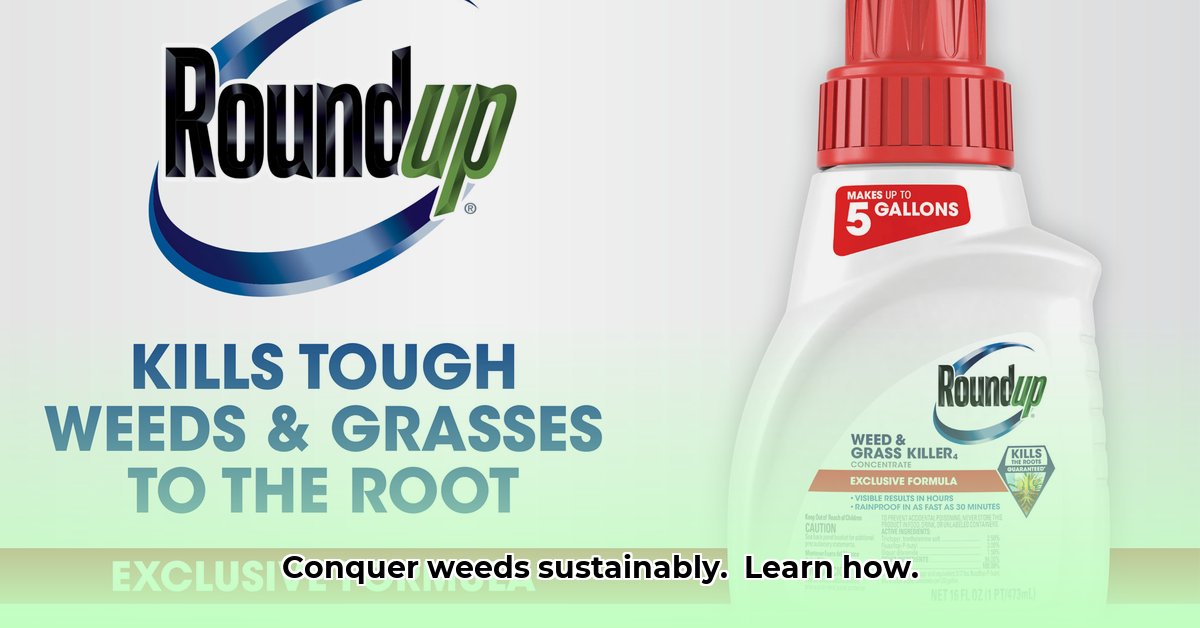
Choosing the right herbicide is crucial for sustainable agriculture. This guide compares Roundup concentrates available at Tractor Supply, analyzing efficacy, cost-effectiveness, and environmental impact to help farmers, landowners, and consumers make informed decisions. For more information on Roundup at Tractor Supply, see this helpful resource: Tractor Supply Roundup.
Understanding Roundup Concentrates
Tractor Supply typically offers two main Roundup formulations: a high-concentration (e.g., 50%) super concentrate and a lower-concentration (e.g., 4%) formulation. Both contain glyphosate, a widely used herbicide effective against various broadleaf and grassy weeds like dandelions and crabgrass.
The high-concentration formulation requires less product per application, potentially lowering the long-term cost if applied precisely. However, precise application is critical to avoid waste and minimize environmental risk.
The lower-concentration formulation requires more product per acre, increasing the upfront cost, while offering a larger margin of error in application. This might be preferable for less experienced users or larger areas.
Roundup Concentrate Efficacy: A Detailed Comparison
Both concentrates effectively control target weeds, but application rates and visible results differ. The higher concentration generally provides faster results with less product usage, while the lower concentration may require more frequent or higher volume applications for similar efficacy. Specific efficacy rates depend on factors such as weed type, environmental conditions, and application methodology. Detailed field trials comparing both products under various conditions are needed to establish precise efficacy comparisons.
Environmental Impact: A Critical Assessment
The environmental impact of glyphosate-based herbicides is a complex and actively debated topic. While glyphosate's toxicity is relatively low, concerns remain about potential soil and water contamination, particularly with improper application. The higher concentration concentrate carries a higher potential risk of environmental damage if not applied with extreme care and precision.
Comprehensive life cycle assessments (LCAs) comparing the environmental impact of both formulations from production to disposal are currently lacking. This data gap highlights the urgent need for further research to inform responsible land management practices. "The lack of robust LCA data is a significant impediment to making truly informed decisions about the sustainability of different herbicide formulations," states Dr. Eleanor Vance, Professor of Environmental Science at the University of California, Berkeley.
Cost-Effectiveness Analysis: A Holistic View
Cost-effectiveness goes beyond the initial purchase price at Tractor Supply. Consider application rates, frequency, labor costs, equipment, and fuel. While the higher concentration may appear more expensive upfront, its lower application rate can potentially result in long-term cost savings if used effectively. The lower concentration, although less expensive initially, might necessitate more frequent applications, offsetting those initial savings. Careful calculation of cost per treated area for both options over a growing season is essential for objective comparison.
Sustainable Alternatives: Beyond Chemical Control
Adopting sustainable weed management practices is crucial for preserving long-term soil health and minimizing environmental impact. Effective alternatives to chemical herbicides include:
- Mechanical weeding: Manual or machine-based removal of weeds.
- Mulching: Applying organic matter to suppress weed growth.
- Biological control: Utilizing natural predators or pathogens to manage weeds.
- Crop rotation: Alternating crops to disrupt weed life cycles.
- Cover cropping: Planting specific crops to outcompete weeds.
These methods often require more labor and time, but their long-term ecological benefits are substantial.
Actionable Intelligence: Practical Recommendations
The optimal approach depends on individual circumstances. Consider these guidelines:
| Stakeholder Group | Short-Term Actions | Long-Term Actions |
|---|---|---|
| Farmers & Landowners | Compare Roundup concentrate options carefully. Practice precise application techniques. Explore sustainable alternatives. | Integrate sustainable practices into weed management strategies. Track costs and environmental impacts. |
| Agricultural Retailers | Offer training on safe and efficient application. Stock and promote a wider range of sustainable weed management tools. | Foster partnerships with researchers and promote sustainable supply chains. |
| Regulatory Agencies | Continue monitoring glyphosate levels. Enforce clear application guidelines. Support sustainable technology R&D. | Develop regulations promoting responsible herbicide use and invest in long-term environmental impact studies. |
Conclusion: The Path Forward
Sustainable weed management demands a balanced approach. While Roundup concentrates can be effective tools, they must be used judiciously and in consideration of their environmental impact. A combination of chemical and non-chemical strategies, coupled with rigorous research into long-term effects and the development and adoption of sustainable alternatives, are imperative for responsible land stewardship. The future of agriculture depends on it.